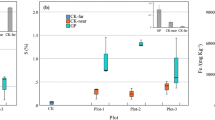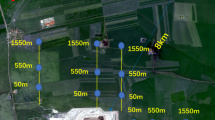Abstract
Purpose
China is the world’s largest coal producer and consumer. Despite extensive studies on coal-burning pollution, the effect of raw coal pollutants caused by transportation and turnover on soil along the road received little attention. The main purpose of the study was to clarify the biogeochemical response of soil ecosystems to raw coal pollution.
Materials and methods
The raw coal and unpolluted soil from the coal distribution area in Xuanhua, China were collected for the incubation experiments. Combined with the determination of soil physicochemical properties, including pH, electric conductivity, soluble ions, dissolved organic carbon, and available heavy metals, the biogeochemical responses of soil to raw coal pollution, such as soil enzyme activities (β-glucosidase, alkaline phosphatase, and Urease), microbial community composition, and soil respiration, were systematically studied. In addition, a q-PCR analysis of the urease was performed to clarify the inhibitory mechanism of urease by coal pollution. Furthermore, a simple field investigation was carried out to confirm the incubation results.
Results and discussion
Raw coal pollution not only changed the soil physicochemical properties but also made the available Zn, Ni, and Co accumulate significantly. A positive priming effect in soil with the low-dose raw coal addition was trigged, but soil respiration rate and soil enzyme activity, such as β-glucosidase and alkaline phosphatase, were inhibited to different degrees with the increased pollution. Urease activity also decreased under the higher coal contamination, which was due to inhibition of ureC gene expression. In addition to the slight soil acidification caused by coal pollution, microbial communities and diversity was also found to be affected. The relative abundances of the microorganisms related to urease, alkaline phosphatase, and β-glucosidase changed accordingly. The incubation results are in good agreement with the field survey results.
Conclusions
Low-dose raw coal pollution can trigger the soil positive priming effect. However, as the coal pollution increased, the β-glucosidase, alkaline phosphatase, and urease in the soil were inhibited to varying degrees. The compounding effects of soil acidification, increased electric conductivity, and the accumulation of available heavy metals such as Zn, Ni, and Co are the key causes for the biogeochemical response of soil to coal pollution.





Similar content being viewed by others
References
Adamo P, Zampella M, Gianfreda L, Renella G, Rutigliano FA, Terribile F (2006) Impact of river overflowing on trace element contamination of volcanic soils in south Italy: part I. Trace element speciation in relation to soil properties. Environ Pollut 144(1):308–316
Dick RP (1994) Soil enzyme activities as indicators of soil quality. Soil Sci Soc Am J 58:107–124
Finkenbein P, Kretschmer K, Kuka K, Klotz S, Heilmeier H (2013) Soil enzyme activities as bioindicators for substrate quality in revegetation of a subtropical coal mining dump. Soil Biol Biochem 56:87–89
Fisher KA, Yarwood SA, James BR (2017) Soil urease activity and bacterial ureC gene copy numbers: effect of pH. Geoderma 285:1–8
Fontaine S, Mariotti A, Abbadie L (2003) The priming effect of organic matter: a question of microbial competition? Soil Biol Biochem 35(6):837–843
Gulser F, Erdogan E (2008) The effects of heavy metal pollution on enzyme activities and basal soil respiration of roadside soils. Environ Monit Assess 145(1–3):127–133
Haichar FZ, Marol C, Berge O, Rangel-Castro JI, Prosser JI, Balesdent J, Heulin T, Achouak W (2008) Plant host habitat and root exudates shape soil bacterial community structure. ISME J 2(12):1221–1230
Hlawiczka S, Korszun K, Fudala J (2016) Acidity of vapor plume from cooling tower mixed with flue gases emitted from coal-fired power plant. Sci Total Environ 554–555:253–258
Hu HW, Zhang LM, Dai Y, Di HJ, He JZ (2013) pH-dependent distribution of soil ammonia oxidizers across a large geographical scale as revealed by high-throughput pyrosequencing. J Soils Sediments 13(8):1439–1449
Huang J, Li Z, Zhang J (2012) Improvement of indophenol blue colorimetric method on activity of urase in soil. J Civil Architect Environ Eng 34(1):102–107 (in Chinese)
Jiang YF, Ling J, Dong JD, Chen B, Zhang YY, Zhang YZ, Wang YS (2015) Illumina-based analysis the microbial diversity associated with Thalassia hemprichii in Xincun Bay, South China Sea. Ecotoxicology 24(7–8):1548–1556
Jones JB (2001) Laboratory guide for conducting soil tests and plant analysis. Nurse Educator 22(4):14,31,43,47
Karaca A, Cetin SC, Turgay OC, Kizilkaya R (2010) Soil enzymes as indication of soil quality. Springer, Berlin Heidelberg
Kim MK, Im WT, In JG, Kim SH, Yang DC (2006) Thermomonas koreensis sp. nov., a mesophilic bacterium isolated from a ginseng field. Int J Syst Evol Micr 56(Pt 7):1615–1619
Kim RY, Yoon JK, Kim TS, Yang JE, Owens G, Kim KR (2015) Bioavailability of heavy metals in soils: definitions and practical implementation--a critical review. Environ Geochem Health 37(6):1041–1061
Kong T, Liu M, Shu M, Wang K, Lyu G (2016) Effect of low molecular weight organic acids on soil microbe number and soil enzyme activities. Environ Chem 35(2):348–354 (in Chinese)
Li LL, Zhang DG, Li TL, Yi YL, Zang J, Hu R (2008) On relation between heavy metal available contents of soil determined by different extractants and of maize organs. Soils 40(5):819–823 (in Chinese)
Li X, Meng D, Li J, Yin H, Liu H, Liu X, Cheng C, Xiao Y, Liu Z, Yan M (2017) Response of soil microbial communities and microbial interactions to long-term heavy metal contamination. Environ Pollut 231(Pt 1):908–917
Lin XG (2010) Principles and methods of soil microbial research. Higher Education Press, Beijing (in Chinese)
Liu YR, Delgado-Baquerizo M, Wang J-T, Hu HW, Yang Z, He JZ (2018) New insights into the role of microbial community composition in driving soil respiration rates. Soil Biol Biochem 118:35–41
Lu L, Jia Z (2013) Urease gene-containing Archaea dominate autotrophic ammonia oxidation in two acid soils. Environ Microbiol 15(6):1795–1809
Macaskie L, Empson R, Cheetham A, Grey C, Skarnulis A (1992) Uranium bioaccumulation by a Citrobacter sp. as a result of enzymically mediated growth of polycrystalline HUO2PO4. Science 257(5071):782–784
Martínez-Toledo Á, Montes-Rocha A, González-Mille DJ, Espinosa-Reyes G, Torres-Dosal A, Mejia-Saavedra JJ, Ilizaliturri-Hernández CA (2016) Evaluation of enzyme activities in long-term polluted soils with mine tailing deposits of San Luis Potosí, México. J Soils Sediments 17(2):364–375
Nayak AK, Raja R, Rao KS, Shukla AK, Mohanty S, Shahid M, Tripathi R, Panda BB, Bhattacharyya P, Kumar A, Lal B, Sethi SK, Puri C, Nayak D, Swain CK (2015) Effect of fly ash application on soil microbial response and heavy metal accumulation in soil and rice plant. Ecotoxicol Environ Saf 114:257–262
Niu S, Gao L, Zhao J (2017) Heavy metals in the soils and plants from a typical restored coal-mining area of Huainan coalfield, China. Environ Monit Assess 189(10):484
Pandey B, Agrawal M, Singh S (2015) Ecological risk assessment of soil contamination by trace elements around coal mining area. J Soils Sediments 16(1):159–168
Peiravi M, Mote SR, Mohanty MK, Liu J (2017) Bioelectrochemical treatment of acid mine drainage (AMD) from an abandoned coal mine under aerobic condition. J Hazard Mater 333:329–338
Quadros PD, Zhalnina K, Davis-Richardson AG, Drew JC, Menezes FB, Camargo FAO, Triplett EW (2016) Coal mining practices reduce the microbial biomass, richness and diversity of soil. Appl Soil Ecol 98:195–203
Schlesinger WH, Andrews JA (2000) Soil respiration and the global carbon cycle. Biogeochemistry 48(1):7–20
Shi CF, Wang ZY, Leng XY, Liu JM, Cao JM (2016) Improvement of soil phosphatase activity measurement method. Experimental Technology and Management 33(7):48–49 (in Chinese)
Streets DG, Lu Z, Levin L, Ter Schure AFH, Sunderland EM (2018) Historical releases of mercury to air, land, and water from coal combustion. Science Total Environ 615:131–140
Susilawati R, Evans PN, Esterle JS, Robbins SJ, Tyson GW, Golding SD, Mares TE (2015) Temporal changes in microbial community composition during culture enrichment experiments with Indonesian coals. J Coal Geol 137:66–76
Tourna M, Stieglmeier M, Spang A, Könneke M, Schintlmeister A, Urich T, Engel M, Schloter M, Wagner M, Richter A (2011) Nitrososphaera viennensis, an ammonia oxidizing archaeon from soil. Proc Natl Acad Sci USA 108(20):8420–8425
Verma SK, Masto RE, Gautam S, Choudhury DP, Ram LC, Maiti SK, Maity S (2015) Investigations on PAHs and trace elements in coal and its combustion residues from a power plant. Fuel 162:138–147
Wang X, Fei S, Liu X, Su X (2014) Effects of single and combined pollution of cadium, nickel on soil enzyme activity. Chinese Journal of Environmental Engineering 8(9):4027–4034
Wu L, Thompson DK, Li G, Hurt RA, Tiedje JM, Zhou J (2001) Development and evaluation of functional gene arrays for detection of selected genes in the environment. Appl Environ Microbiol 67(12):5780–5790
Wyszkowska J, Boros E (2005) Effect of nickel contamination on soil enzymatic activities. Plant Soil Environ 51(12):523–531
Xu BL, Zhong WH, Huang QR, Qin HY, Deng H, Han C (2017) Nitrification activity and autotrophic nitrifiers in long-term fertilized acidic upland soils. Environ Sci 38(8):3473–3482 (in Chinese)
Yang ZX, Shu Q, Zheng DW, Feng SD (2006) Effects of cadium, zinc and lead on soil enzyme activities. J Environ Sci 18(6):1135–1141
Yang TT, Liu J, Chen WC, Chen X, Shu HY, Jia P, Liao B, Shu WS, Li JT (2017) Changes in microbial community composition following phytostabilization of an extremely acidic Cu mine tailings. Soil Biol Biochem 114:52–58
Yu-Xiao HE, Zhao TQ, Liu GC, Guo XM, Wei YL (2012) Influence of heavy metal contents on the activities of soil enzyme in coalmining subsided area. J Soil Water Conserv 26(1):214–218
Zahran HH (1997) Diversity, adaptation and activity of the bacterial flora in saline environments. Biol Fertili Soils 25(3):211–223
Zhong XL, Zhou SL, Li JT, Zhao QG (2010) Soil available Cd, Cu, Pb distribution characteristic and Its influencing factors. Scientia Geographica Sinica 30(2):254–220 (in Chinese)
Acknowledgments
We also give our thanks to professor Ping Li for the valuable suggestions.
Funding
The research was funded by the Natural Science Foundation of China (NSFC 41472316), the Hebei Provincial Department of Finance (2121299), and the Hunan Provincial Key Laboratory for Evaluation and Utilization of Land Resources (SYS-ZX-201802) and the Fundamental Research Funds for the Central University (CUG170104).
Author information
Authors and Affiliations
Corresponding author
Additional information
Responsible editor: Chengrong Chen
Publisher’s note
Springer Nature remains neutral with regard to jurisdictional claims in published maps and institutional affiliations.
Rights and permissions
About this article
Cite this article
Liu, Y., Xiang, W., Zhu, J. et al. Biogeochemical responses of soil ecosystems to raw coal pollution in Xuanhua, China. J Soils Sediments 20, 181–189 (2020). https://doi.org/10.1007/s11368-019-02387-3
Received:
Accepted:
Published:
Issue Date:
DOI: https://doi.org/10.1007/s11368-019-02387-3




